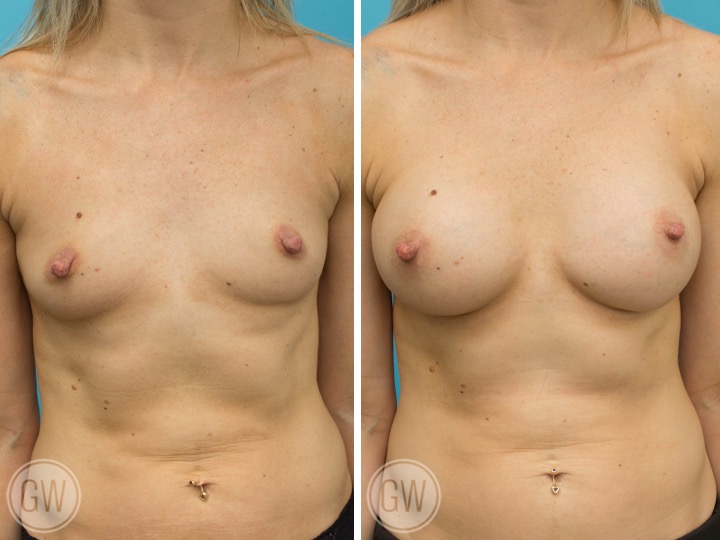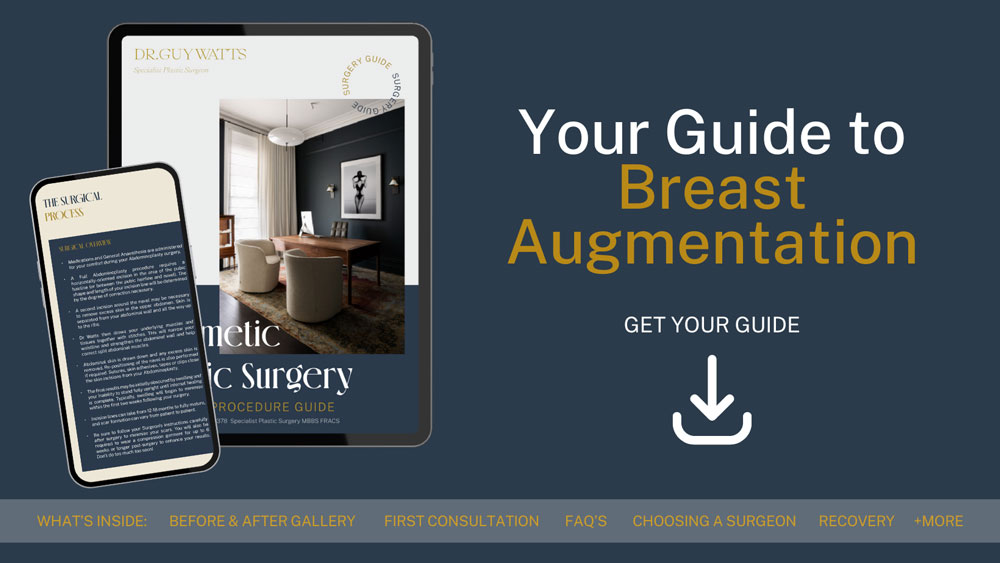
17 Jul Recovery After Breast Augmentation
Dr. Guy Watts, Specialist Plastic & Reconstructive Surgeon in Perth, Western Australia, understands that breast augmentation is a significant procedure that requires careful post-operative care for optimal healing. Whether you are undergoing breast augmentation for cosmetic adjustment or reconstructive purposes, it is essential to understand the recovery process to set realistic expectations and support optimal outcomes.
Recovery varies for every patient based on factors such as individual healing capacity, implant placement, surgical technique, and adherence to post-operative care instructions. However, there is a general timeline that most patients follow, which includes key milestones in healing, activity restrictions, and gradual resumption of daily routines. This guide will provide a detailed breakdown of what to expect after breast augmentation, offering insights into each stage of recovery and tips to help you heal effectively.
Take our quiz, and find out if you are ready for surgery
Understanding the Breast Augmentation Recovery Timeline
· The First 24-48 Hours: Immediate Post-Surgery Care
Immediately after surgery, patients will be taken to a recovery area where they will be closely monitored as they wake up from anaesthesia. Some patients may experience grogginess, nausea, or dizziness, which are common temporary side effects of anaesthesia. The chest area may feel tight and swollen, as the body begins adjusting to the presence of implants. This tightness is more pronounced in patients who have implants placed under the pectoral muscle, as the muscle requires time to relax and accommodate the implant.
Pain is generally manageable with prescribed medications, and discomfort is typically described as a sensation of pressure rather than sharp pain. Patients are required to wear a surgical compression bra, which provides support, manages swelling, and helps stabilise the implants. It is important to rest with the upper body elevated to limit swelling and assist circulation. Some mild bruising may be visible, but this will gradually subside over the following days.
Most patients return home on the same day of surgery, but in some cases, an overnight hospital stay may be recommended for additional monitoring. It is essential to have a responsible adult available to drive the patient home and assist with basic tasks for the first 24-48 hours.
· The First Week: Managing Swelling and Comfort
During the first week after surgery, rest and limited movement are crucial to assist proper healing. Patients may continue to experience swelling, bruising, and tenderness, but these symptoms are expected to improve each day. While it is important to rest, gentle walking around the house is encouraged to prevent blood clots and promote circulation.
Patients should avoid any movements that strain the chest muscles, including lifting their arms overhead, pushing, pulling, or carrying heavy objects. Engaging in excessive movement can increase swelling and may impact healing. Most patients find that pain subsides significantly after the first few days, and some can begin transitioning from prescription pain medications to over-the-counter options, as advised by their surgeon.
By the end of the first week, many patients feel well enough to return to office-based work or non-physical jobs, provided that they continue to avoid heavy lifting or strenuous activities. A follow-up appointment with Dr. Watts will be scheduled to assess healing progress, check incisions, and remove any surgical dressings if necessary.
· Weeks 2-4: Resuming Normal Activities
As patients move into the second and third weeks of recovery, they typically notice a significant reduction in swelling and bruising. Many begin feeling more comfortable and can resume most of their daily activities, but it is important to continue following post-operative restrictions. Heavy lifting, intense physical activities, and exercises that engage the chest muscles should still be avoided.
The implants will start to settle into a more natural position during this period. Initially, they may appear high on the chest, but over time, they will gradually drop into place as swelling decreases and the surrounding tissues relax. Patients should continue wearing their compression garment as advised, as this helps support the implants and aids in achieving the desired final shape.
By the end of the third or fourth week, many patients can return to light exercise, such as walking or using a stationary bike, as long as there is no excessive bouncing or strain on the upper body. Each patient’s healing process is different, so it is essential to follow Dr. Watts’ personalised recommendations.
· Weeks 4-6: Increasing Mobility and Light Exercise
By the one-month mark, most patients feel well enough to engage in more physical activities, but it is still important to be cautious when resuming workouts. Light lower-body exercises, such as gentle squats or lunges, may be introduced, but any activity that places stress on the chest muscles should still be avoided. Strength training, push-ups, and high-impact exercises should only be resumed when approved by Dr. Watts.
At this stage, most of the swelling will have resolved, and the implants will have dropped further into a more natural position. Patients may begin transitioning to a soft, non-underwired bra, although underwired bras should still be avoided to prevent irritation along the incision sites.
A follow-up consultation will typically be scheduled around this time to assess healing and discuss any additional recovery steps.
· Months 3-6: Final Stages of Healing
By three months post-surgery, patients can expect the majority of swelling to have subsided, revealing a more natural breast shape. The implants will have settled into place, and the breasts will feel softer as the surrounding tissues continue to adjust. Scars will begin to fade, but full scar maturation can take up to 12 months. Patients can support scar healing by following their surgeon’s recommendations, which may include scar creams, silicone sheets, or massage techniques.
Most patients can return to all normal activities, including high-impact workouts, weight training, and more intensive exercises, as long as they feel comfortable and have received clearance from their surgeon. Regular follow-ups with Dr. Watts will help monitor healing progress and assess the surgical outcome.
DOWNLOAD DR WATTS’ GUIDE TO BREAST AUGMENTATION

Common Myths vs. Facts About Breast Augmentation Recovery
✗ Myth: “Recovery from breast augmentation is extremely painful.”
✓ Fact: While some discomfort is expected, most patients describe the sensation as tightness or pressure rather than severe pain. Proper pain management and rest help make the recovery process manageable.
✗ Myth: “You won’t be able to lift your arms for weeks after surgery.”
✓ Fact: Patients are encouraged to move their arms gently soon after surgery to prevent stiffness, but heavy lifting and strenuous activity should be avoided until healing progresses.
✗ Myth: “Implants will look perfect immediately after surgery.”
✓ Fact: The initial appearance of the breasts will change as swelling decreases and the implants settle. It may take several months for the final results to be visible.
Pre- and Post-Operative Care Tips for a Smooth Recovery
Patients who follow a structured pre- and post-operative care plan typically experience a smoother recovery. Before surgery, it is important to prepare by arranging time off work, setting up a comfortable resting area at home, and following pre-operative instructions provided by Dr. Watts. After surgery, wearing the recommended compression garment, sleeping in an elevated position, maintaining hydration, and eating a nutritious diet all contribute to a better healing experience.
Understanding the common mistakes surgeons can make during breast augmentation is just as important to ensure a safe and successful outcome. Read about the biggest mistakes surgeons make with breast augmentation surgery to know what to look out for.
Avoiding smoking and alcohol is also critical, as both can slow down healing and increase the risk of complications. Patients should also attend all scheduled follow-up appointments to support monitoring of their recovery and to address any concerns that may arise.
FAQs about Recovery After Breast Augmentation
Final Thoughts: Trust Dr. Guy Watts for Expert Breast Augmentation Care
Breast augmentation recovery is a gradual process, but with the right approach and expert guidance, patients can achieve long-lasting and natural-looking results. Dr. Guy Watts, Specialist Plastic & Reconstructive Surgeon in Perth, provides personalised care and detailed recovery plans tailored to each patient’s needs.
For more information about breast augmentation or to schedule a consultation, visit Dr. Watts’ office or call (08) 9286 1600 and take the next step toward achieving your aesthetic goals.
Further Reading
- Read more about Guy Watts’ blog on Recovery after Plastic Surgery
About Dr. Guy Watts – MED0001539378
FRACS (Plas) – Specialist Plastic Surgeon In Perth WA
Dr. Guy Watts is a Specialist Plastic Surgeon (AHPRA MED0001539378) with an extensive career that spans across renowned plastic surgery clinics worldwide. His experience has been honed through invaluable experiences at esteemed establishments such as the New York Eye and Ear Infirmary and the renowned Pitanguy Clinic in Brazil.
Having collaborated with the foremost cosmetic plastic surgeons on a global scale, Dr. Watts has chosen to return to Perth after a 17-year journey of intensive training and invaluable professional experience to bring the latest practices and technology in cosmetic plastic surgery to his patients.
Dr. Watts is a Fellow of the Royal Australasian College of Surgeons (FRACS) and a Member of the Australian Society of Plastic Surgeons (ASPS), Australasian Society of Aesthetic Plastic Surgeons (ASAPS) and the International Society of Aesthetic Plastic Surgeons (ISAPS).
Read about the potential Risks and Complications of Surgery
Read the Patient Information and Resources
About CLINISPA
Clinispa is Dr Watts’ bespoke medical clinic performing Cosmetic Aesthetic treatments. At Clinispa, we offer advanced clinical treatments in a luxurious and calming environment, tailored to support your skin’s health and appearance.
Clinispa aesthetic services are performed by Dr Guy Watts’ nursing professionals, who have a passion for and solid understanding of facial aesthetics.
All Clinispa clients are considered individually, with a personalised treatment plan consisting of advanced scientific approaches to cosmetic aesthetics. We incorporate innovative technologies in conjunction with superiorly formulated skin care.
For more information about the full range of Clinispa Aesthetic of Cosmetic Treatments visit the Clinispa website








Sorry, the comment form is closed at this time.